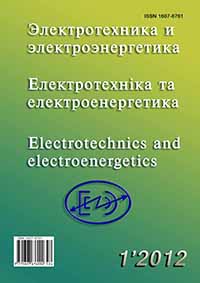Justification of the approach to impact compensation of the induction motor parametric asymmetry within the frequency-contropped electric drive
DOI:
https://doi.org/10.15588/1607-6761-2012-1-9Keywords:
asynchronous motor, the instantaneous power theory, power harmonic componentsAbstract
The analysis of existing approaches to the compensation of higher harmonics in the current and power signals of threephase systems is carried out. The advantages and disadvantages of the three main power theories are defined according to their application for compensation of the higher harmonic components in active and reactive power. The necessity of variable components compensation of three-phase induction motor active power caused by its parameters asymmetry is shown. The compensation method of these components within the frequency-controlled electric drive is proposed.References
Кумаков, Ю. А. Инверторы напряжения со ступенчатой модуляцией и активная фильтрация высших гармонік / Ю. А. Кумаков // Новости электротехники. – 2005. – №6 (36). – С. 27–38.
Домнин, И. Ф. Современные теории мощности и их использование в преобразовательных системах силовой электроники / И. Ф. Домнин, Г. Г. Жемеров, Д. С. Крилов, Е. И. Сокол // Техн. електродинаміка. – 2004. – Тем. випуск. – С. 80–91.
Czarnecki, L. S. Instantaneous reactive power p-q theory and power properties of three-phase systems / Leszek S. Czarnecki // IEEE Transactions on Power Delivery. – January 2006. – № 1, Vol. 21. – Рp. 362–367.
Czarnecki, L. S. Comments to the paper: Instantaneous p-q theory for compensating nonsinusoidal systems / Leszek S. Czarnecki // Przeglad elektrotechniczny (Electrical review. – 2009. – NR 6, R. 85. – Рp. 167–169.
Akagi, H. Generalized theory of the instantaneous reactive power in three-phase circuits / H. Akagi, Y. Kanazawa, A. Nabae // IPEC’83 – Int. Power Electronics Conf. – Tokyo, Japan, 1983. – Рр. 1375–1386.
Yarymbash, D. S., S. T Yarymbash, T. E. Divchuk, & I. M. Kylymnik. "THE FEATURES OF MAGNETIC FLUX DISTRIBUTION OF THE IDLING MODE OF THE POWER TRANSFORMERS." Electrical Engineering and Power Engineering [Online], 2 (2016): 5-12.
Downloads
How to Cite
Issue
Section
License
Copyright (c) 2017 A. V. Chumachova, A. P. Kalinov

This work is licensed under a Creative Commons Attribution 4.0 International License.
Creative Commons Licensing Notifications in the Copyright Notices
Authors who publish with this journal agree to the following terms:
Authors retain copyright and grant the journal right of first publication with the work simultaneously licensed under aCreative Commons Attribution License that allows others to share the work with an acknowledgement of the work's authorship and initial publication in this journal.
Authors are able to enter into separate, additional contractual arrangements for the non-exclusive distribution of the journal's published version of the work (e.g., post it to an institutional repository or publish it in a book), with an acknowledgement of its initial publication in this journal.
Authors are permitted and encouraged to post their work online (e.g., in institutional repositories or on their website) prior to and during the submission process, as it can lead to productive exchanges, as well as earlier and greater citation of published work.

